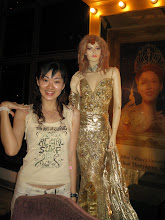第七站:阿育大亚王的雕像
The famous long rifle, with images of fighting cocks. Statue of King Naresuan in Ayutthaya.
从Wat Phu Khao Thong出来,就可看到非常“壮观”的纪念碑了这个王可是够大牌的了。不仅有自己的雕像,还有其他特别的雕刻在墙上,如他身前用的武器,他经历的战争,一切都栩栩如生
由于这个大王很爱斗鸡,所以后人就买了这些雕像来供奉这位王,呵呵。。很夸张哦!纪念碑的前面都摆放了很多种鸡。。除了斗鸡以外,其他的鸡都是弯腰行礼的姿势。
我们呢,也在这里拍招拍得不亦乐乎。。
由于这个大王很爱斗鸡,所以后人就买了这些雕像来供奉这位王,呵呵。。很夸张哦!纪念碑的前面都摆放了很多种鸡。。除了斗鸡以外,其他的鸡都是弯腰行礼的姿势。
我们呢,也在这里拍招拍得不亦乐乎。。

第八站:Wat Chai Wattanaram
个人认为这是必到的景点 因为这是最壮观的,也是保留的最完整的。。很赞叹!
个人认为这是必到的景点 因为这是最壮观的,也是保留的最完整的。。很赞叹!
Standing right on the river, Wat Chai Wattanaram is, in our view, one of the most impressive of the remaining monuments of old Ayutthaya. It was built in 1629 by King Prasat Tong, probably on the site of his mother's cremation. King Prasat Tong was actually a commoner who overthrew the previous king and took the throne. The monastary may well have been established to assert his legitimacy to the throne.
Remains of a Buddha image from the sacked temple. The solid corn-cob prang sits on an elevated terrace in the middle of a courtyard. Chapels at each of the four corners of the courtyard and at the mid-points of each side are topped by smaller prangs. The outside wall of the courtyard is decorated with pilasters which once simulated turned wooden ballustrades.
Along the inner wall of the courtyard are lines of Buddha images. In some of the corner chapels, you can still see what's left of the crowned Buddhas, as well as the coffered ceiling which still shows signs of fire.
The ubosot once stood in front of the northwest entry, along the river. Climb up the northwest stairway of the prang for an excellent view of the remains of the ubosot as well as the rest of Ayutthaya.
The ubosot sat on a terrace the same height as the terrace supporting the prang. All that remains of the ubosot are its base and a couple of Buddha images where the alter used to be. In the lower terraces on either side of the ubosot are another pair of prangs.
Along the outer wall on the northern sides, you can still see a few tantalizing fragments of the extensive high reliefs which decorated the outside of the cloister
Remains of a Buddha image from the sacked temple. The solid corn-cob prang sits on an elevated terrace in the middle of a courtyard. Chapels at each of the four corners of the courtyard and at the mid-points of each side are topped by smaller prangs. The outside wall of the courtyard is decorated with pilasters which once simulated turned wooden ballustrades.
Along the inner wall of the courtyard are lines of Buddha images. In some of the corner chapels, you can still see what's left of the crowned Buddhas, as well as the coffered ceiling which still shows signs of fire.
The ubosot once stood in front of the northwest entry, along the river. Climb up the northwest stairway of the prang for an excellent view of the remains of the ubosot as well as the rest of Ayutthaya.
The ubosot sat on a terrace the same height as the terrace supporting the prang. All that remains of the ubosot are its base and a couple of Buddha images where the alter used to be. In the lower terraces on either side of the ubosot are another pair of prangs.
Along the outer wall on the northern sides, you can still see a few tantalizing fragments of the extensive high reliefs which decorated the outside of the cloister
资料来源:http://thailandforvisitors.com/central/ayuthaya/watanaram/index.html


No comments:
Post a Comment